If you’re new to the world of lock picking, the abundance of technical terms and jargon used by experts can be intimidating. However, it’s crucial to grasp these terms to effectively learn and apply lock picking methods.
In this article, I will simplify the most frequently used lock picking terms for beginners and elaborate on their definitions, making it easier for them to understand what lock picking is.
Contents
- 1 What is Lock Picking?
- 2 Lock Picking Terms for Beginners
- 2.1 Terms Related to Lock Picking Tools
- 2.2 Terms related to Lock Components
- 2.3 Terms related to Lock Picking Techniques
- 2.4 Lock Picking Terms and Definitions
- 2.4.1 1. Binding Pin
- 2.4.2 2. False Set
- 2.4.3 3. Overset
- 2.4.4 4. Feedback
- 2.4.5 5. Tension
- 2.4.6 6. Serrated Pins
- 2.4.7 7. Spool Pins
- 2.4.8 8. Security Pins
- 2.4.9 9. Master Key System
- 2.4.10 10. Key Blanks
- 2.4.11 11. Lock Body/Shell /housing/ hull
- 2.4.12 12. Plug core
- 2.4.13 13. Keyway
- 2.4.14 14. Binding order
- 2.4.15 15. Kinetic order
- 3 Conclusion
- 4 FAQs
- 5 Resources
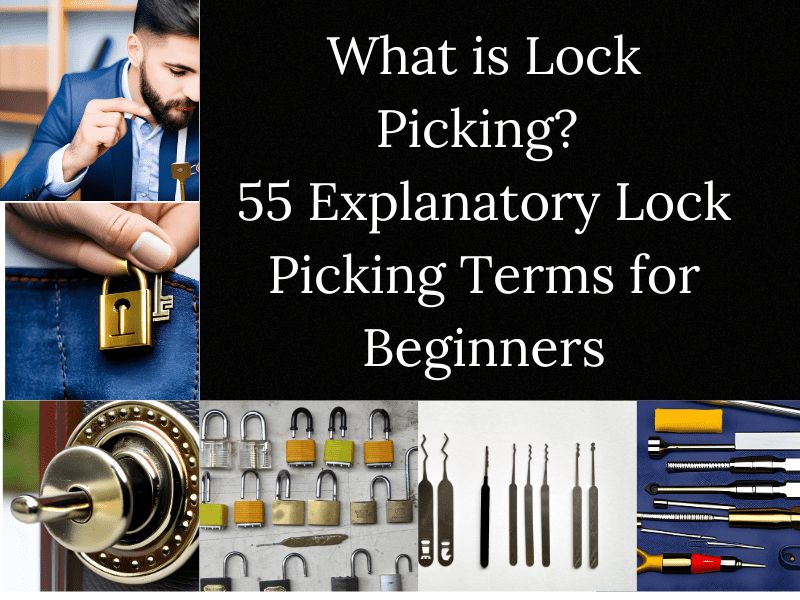
What is Lock Picking?
Lock picking refers to the practice of manipulating the internal components of a lock to open it without using the original key.
To accomplish this, lock pickers rely on specialized tools and techniques that allow them to move the pins or tumblers within the lock to the proper position, thus allowing the lock to turn and release.
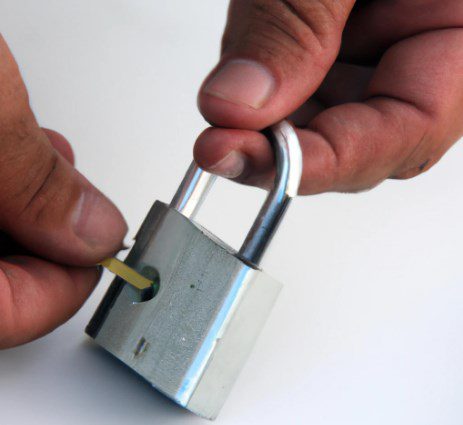
While lock picking may be employed for lawful purposes, such as when an individual is locked out of their property and needs to regain entry, it may also be utilized for illicit purposes like burglary. Know more about lock picking as a hobby, sports or a crime here.
Lock Picking Terms for Beginners
I identify the lock picking terms for beginners by classifying them into aspects related to lock picking tools, lock components, lock picking techniques, and general terms as well as definitions.
Terms Related to Lock Picking Tools
The coming part of this article will provide a lock picking guide on terms related to the tools associated with lock picking. This will help you as a beginner to identify what you can use to pick a lock.
1. Tension Wrench
A tension wrench is used to apply tension to the lock, which creates a bind on the pins inside. It’s a thin, L-shaped piece of metal, usually made from spring steel.
2. Top of Keyway (TOK)
TOK refers to the top of the keyway, where the tension wrench is inserted.

3. Bottom of Keyway (BOK)
BOK refers to the bottom of the keyway, where the pick is inserted.

4. Pick
It is a tool that consists of a long, thin piece of metal with a curved or angled tip. A pick is used to manipulate the pins inside the lock.

5. Rake
A tool called a rake, which is equipped with multiple peaks and valleys, is commonly used to efficiently manipulate multiple pins at the same time.
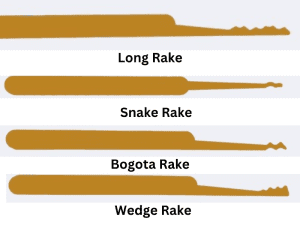
The rakes can further be classified based on their shapes as follows:
- City Rake or Long Rake is a specialized tool used for lock picking. It refers to a type of tool that is utilized to manipulate the pins within a lock mechanism.
This tool is typically longer and wider than a standard rake, providing the user with greater control and precision when working with the lock.
The long rake is commonly utilized by professional locksmiths and other skilled individuals who require a high level of proficiency and accuracy in their work.
- The Snake Rake is also known as the S rake. The pointed tail of this tool folds like an appearance of a snake which is why it is called a snake rake.
- The Bogota Rake was named after the Bogota Mountains as the tail of this tool has the shape of two or three humps like the mountains of Bogota.
- The Wedge Rake has the shape of wedges in the tail giving it an appearance of a toothbrush. This type of rake is least preferred by professionals.
6. Hook
Manipulation of pins is required to pick the locks and a hook is used to manipulate pins one at a time because it is a pick with a single peak.
The hooks can further be classified based on their shapes as follows:

- Gonzo Hook is called gonzo because of its turned shape at the tail resembling the character Gonzo in Muppets.
- Gems Hook is similar to Gonzo Hook but with a cutoff tip.
7. Diamond
The tip of such tools consists of a diamond-shaped tip. Pins with multiple shear lines are manipulated with diamond tools.
- Half-Diamond: The tip of such tools consists of a half-diamond-shaped tip. Pins with single-shear lines are manipulated with half-diamond picking tools.

- There are also small and large half-diamond picking tools with a difference in the size of a diamond. Large half-diamond picking tools take more space while picking a lock and perform better as well.
8. Ball
Warded locks are manipulated with the help of spherical tip tools called a ball.
- Half Ball has a tip that gives the appearance of a ball being cut in half.
- Double Ball has two ball-shaped tips with one ball appearing like the head of a snowman and the other one appearing like the body of a snowman.
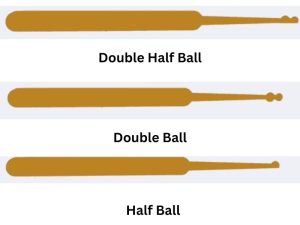
- Double Half Ball has a tip that gives the appearance of two balls being cut in half and lying in a horizontal position.
9. Extractor
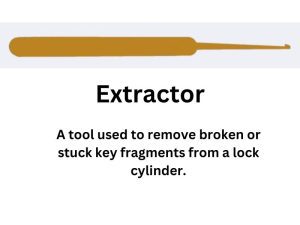
An extractor tool in lock picking is a tool used to remove broken or stuck key fragments from a lock cylinder. Extractor tools come in various shapes and sizes to fit different types of locks.
10. Warded
These tools have a unique shape to help them in manipulating warded locks, which do not have pins but obstructions.
Having reached this point, if you want to go ahead with knowledge of A Summary of Lockpicking, this is the right spot for you.
Understanding the components of a lock is essential for effective lock picking. Let’s go through related lockpicking terms below:

1. Pins
In lock picking, pins are vital components that fit into the keyway. These small cylindrical pieces move up and down, and when they align perfectly at the shear line, the lock can be effortlessly turned open.
Understanding how these pins work can help locksmiths and enthusiasts alike to master the art of lock picking. For more information on pins and their crucial role in lock picking, keep reading our expert guides and articles.
2. Springs
Springs are a crucial component of a lock’s mechanism, playing a critical role in ensuring that the pins function properly. When tension is released, springs push the pins back up to their original position, allowing the lock to reset itself. Without properly functioning springs, a lock would be rendered useless, and picking it would be a nearly impossible feat.
3. Shear Line
The shear line is the separation between the plug and the housing of the lock. When the pins align at the shear line, the lock can be turned open.
4. Driver Pins
Driver pins are located above the key pins. They move up and down with the key pins.
5. Key Pins
Key pins are located at the bottom of the pin stack. They’re of varying lengths and correspond to the key that opens the lock.
6. Shimming
Shimming is a lock bypass method that involves inserting a thin, flexible metal or plastic shim between a lock’s cylinder and housing. It disengages the locking mechanism and allows easy opening of the shackle or bolt.
Other parts of lock include shank, locking bar, plug rear protection plate, and latches.
Do you want to know if parts of lock get damaged by lock picking or not? if yes then click here.
The coming part of this article will dive into the lock picking guide of terms related to the techniques associated with lock picking.
1. Single Pin Picking
When you manipulate each pin individually until their alignment at the shear line, it is termed single pin picking.
2. Raking
Raking requires quick and repeated movement of a rake pick, up and down the pins, to set them at the shear line.
3. Bumping
In the Bumping technique, you insert a specially cut key into the lock and then strike it with a bump hammer to jar the pins into the shear line.
4. Jiggling
Jiggling requires movement of a pick, up and down the pins, in a random pattern for getting them to set at the shear line.
Lock Picking Terms and Definitions
Here are some of the most important lockpicking terms and definitions that every beginner should know:
1. Binding Pin
A binding pin is a pin that is held in place by the tension wrench. The binding pin requires manipulation by the lock picking expert to open the lock because it is a pin that is held in place by the tension wrench.
2. False Set
A false set occurs when the pins seem to be aligned at the shear line, but the lock still won’t turn. This is usually because one or more pins are caught on the edge of the shear line.
3. Overset
When a pin is lifted too high and becomes stuck above the shear line, it is called an overset.
4. Feedback
The physical sensation which is felt by the lock picker when a pin sets at the shear line is the feedback, commonly referred to as resistance or slight click.
5. Tension
Tension is the amount of pressure applied to the tension wrench.
6. Serrated Pins
Serrated pins have serrations along the length of the pin. They’re designed to make lock picking more difficult.
7. Spool Pins
Spool pins are shaped like an hourglass, with a narrow waist. They’re also designed to make lock picking more difficult.
8. Security Pins
Security pins (serrated, spool, or mushroom-shaped) are any pins that are intended to increase the difficulty of lock picking.
9. Master Key System
A master key system is a system in which one key can open multiple locks. It’s often used in commercial or institutional settings.
10. Key Blanks
Key blanks are metal forms into which the teeth of a key are carved. These are metal pieces with slots carved onto their edges to accommodate various locks.
- Head: The larger, often decorative part of the key that is used to grip and turn the key.
- Blade: The straight, flat part of the key that is inserted into the lock.
- Shoulder: The part of the key that rests against the lock when it is fully inserted.
- Tip: The end of the key opposite the head.
- Cuts: The grooves along the blade of the key that corresponds to the pins or tumblers in the lock.
- Biting profile: The specific pattern of cuts along the blade of the key that allow it to operate a specific lock.
11. Lock Body/Shell /housing/ hull
The lock body, lock shell, lock housing, and lock hull are all terms used to describe the outer casing of a lock. This is part of the lock that encases the internal components, including the locking mechanism and keyway and is usually made of metal or other durable materials.
The lock body/shell/housing/hull is typically mounted to a door, gate, or other structure using screws or other fasteners, and may feature additional components such as a latch or deadbolt.
12. Plug core
A plug core is a component in a pin tumbler lock that contains the keyway and rotates when the correct key is inserted.
It houses the key pins and driver pins, and its rotation releases the lock’s bolt or latch. The plug core is an essential part of the lock and is typically made of brass or other durable materials.
13. Keyway
A keyway is a small groove in a lock that accepts a specific key. It’s unique to the lock and helps to ensure that only authorized users can access it.
- A paracentric keyway is a high-security lock design with a narrow, offset channel that makes it difficult to pick. It may have additional security features like false gates.
- Non-Paracentric keyways are standard and lack the offset channel, making them easier to pick, but still effective for lower-security applications.
14. Binding order
In lock picking, the binding order refers to the order in which the pins within the lock must be set to their correct positions to successfully unlock the lock. The binding order can vary depending on the lock and the specific technique being used to pick it.
15. Kinetic order
Progressive pinning or kinetic order is a technique used in lock rekeying where the pins within the lock are rearranged in a specific order to increase the difficulty of picking the lock.
- Zip is a lock picking technique where the lock pick is quickly inserted and removed from the lock while applying a slight amount of tension. This technique is repeated rapidly and can cause the pins to jump to their correct position, unlocking the lock.
- Rock is a lock picking technique where the lock pick is used to push individual pins up and down while applying slight tension to the lock cylinder. This technique is repeated until all of the pins are set to their correct position and the lock is unlocked.
- Rake is a lock picking technique where the lock pick is inserted into the lock and moved rapidly up and down while applying a slight amount of tension to the lock cylinder. This technique can cause the pins to bounce and jump to their correct position, allowing the lock to be unlocked quickly.
Here is your shot if you want to know more about Lock Picking: A Beginner’s Guide to Covert Entry.
Conclusion
As a beginner in lock picking, it’s important to understand the technical terms and definitions associated with the practice. By familiarizing yourself with the tools, components, techniques, and lock picking terms for beginners, you’ll be on your way to becoming a proficient lock picker.
FAQs
How helpful are lock picking terms for beginners in learning lock picking?
Knowing lock picking terms for beginners, allows any learner to pick lock picking concepts in a short period which means they are very helpful.
How long does it take to learn lock picking?
It can take anywhere from a few weeks to several months to become proficient in lock picking.
Can any lock be picked?
No, not all locks can be picked. Some locks are designed to be pick-resistant.
Is lock picking a useful skill?
Lock picking can be a useful skill for locksmiths, law enforcement, and security professionals.
Are there any risks associated with lock picking?
Lock picking can damage locks if done incorrectly, and it should only be attempted on locks that you own or have permission to pick.
Is Lock Picking a Sports?
Yes, the technical term used for it is Locksports, in which the lock picking enthusiasts compete with each other with sportman spirit and share their experience with each other. If you want to know more about it, click here.
Resources
- Lock Picking: A Beginner’s Guide to Covert Entry by JORDAN SMITH
- A Summary of Lockpicking by OFC SARL
- MIT Guide to Lock Picking
- BEGINNERS GUIDE TO LOCK PICKING March 11, 2019 by Ashley Adamant
- Lock Picking Encyclopedia
